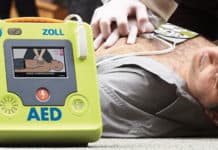Since the onset of the COVID-19 pandemic, lay-administered CPR has suffered greatly due to fears of infection. Business facilities, by virtue of their high human occupancy and traffic, are crucial venues to protect against out-of-hospital cardiac arrest (OHCA). Therefore, business facilities have a responsibility to institute relevant changes to empower employees to perform CPR safely.
As the COVID-19 pandemic continues to surge across the world, it is impacting bystander intervention in response to witnessed OHCA. A study conducted by researchers at Avive, a San Francisco-based privately held healthcare technology company, indicates that CPR instructors harbor great concern about increased bystander reluctance to help victims of OHCA due to fear of exposing themselves to COVID-19.
According to the survey, 74% of CPR instructors are either moderately or strongly concerned that the pandemic has increased bystander hesitancy to offer CPR to victims of OHCA. The CPR instructors surveyed also indicated that there has been decreased interest in learning CPR since the pandemic broke out. 52% of the respondents reported having less than half of the student volumes they had before COVID.
Bystander CPR is critical in increasing survival chances as it maintains blood flow in victims whose hearts have stopped beating before the paramedics arrive. Sudden cardiac arrest is an extremely dire condition, killing 100% of victims if CPR and defibrillation are not performed within the first few minutes after onset.
By placing lay responders in the first line of defense against OHCA, health authorities hope to improve survival. The observed increase in bystander hesitation due to COVID-19 goes against that goal. One of the recommendations that the American Heart Association and other health organizations have consistently pushed for is the presence of personnel trained in CPR at all business facilities. In a post-COVID world, this crucial element of SCA response is compromised, affecting the ability of businesses to protect employees and customers on their premises from death due to cardiac arrest.
These findings suggest that business facilities will need to institute new measures to empower their employees to respond safely to OHCA incidents on their premises. Such measures include the provision of protective gear, and encouraging CPR/AED training among employees, including adapted courses that maintain social distance. There is an established connection between CPR training and bystanders readiness to help victims of OHCA. Even during the pandemic, lay bystanders with CPR training are more willing to attempt resuscitation and PPE availability similarly increases motivation to perform CPR.
Just as with the provision of AEDs at every public space, business facilities have a duty to institute these changes because sudden cardiac arrest is a highly unpredictable occurrence that could happen to anyone, anytime, anywhere.
The full report can be found at https://avive.life/reports/cpr-training-during-covid-19/.



















![[VIDEO] Collect Asset Data at the Speed of Walking a Building](https://facilityexecutive.com/wp-content/uploads/2024/02/maxresdefault-324x160.jpg)